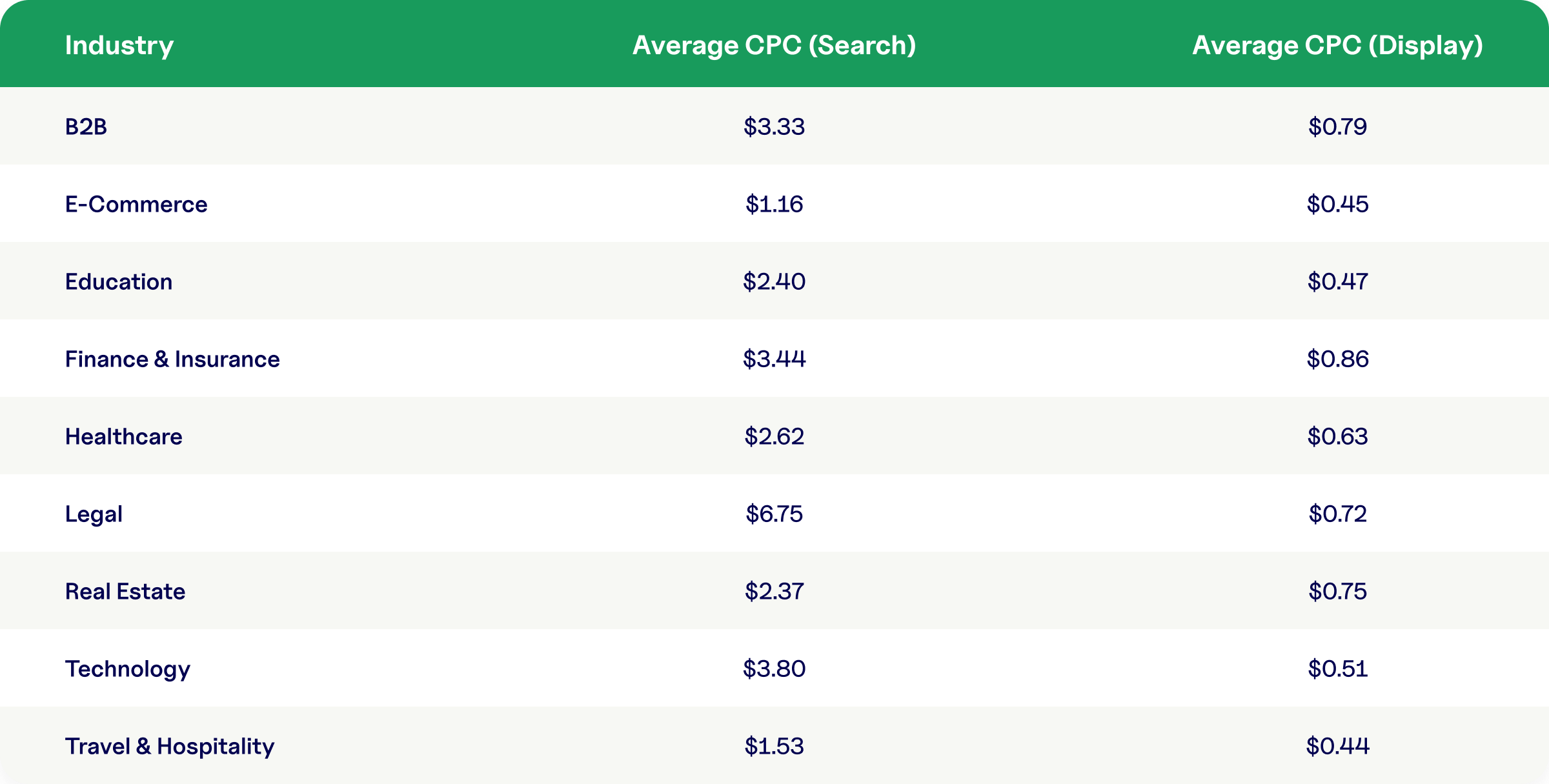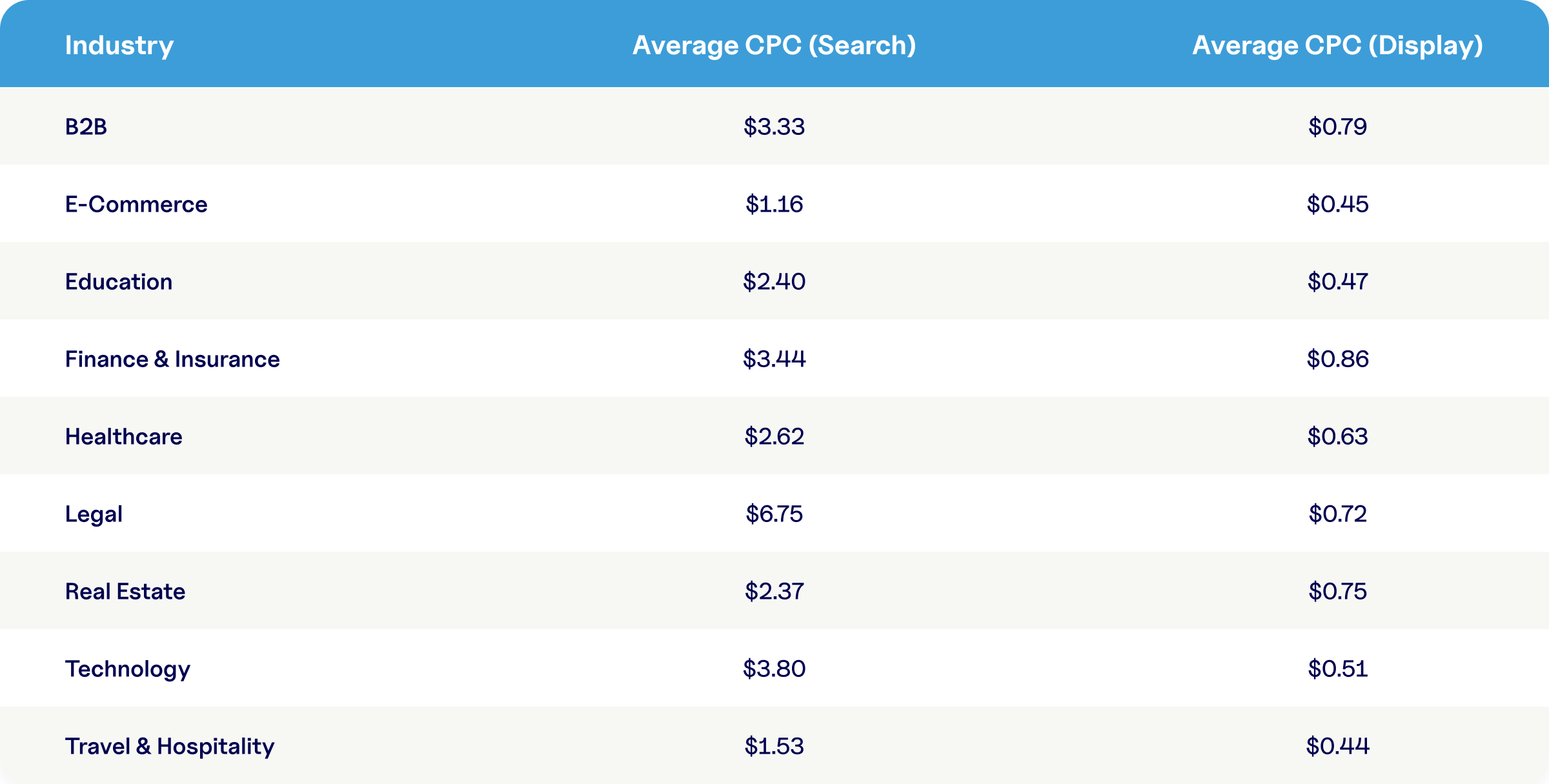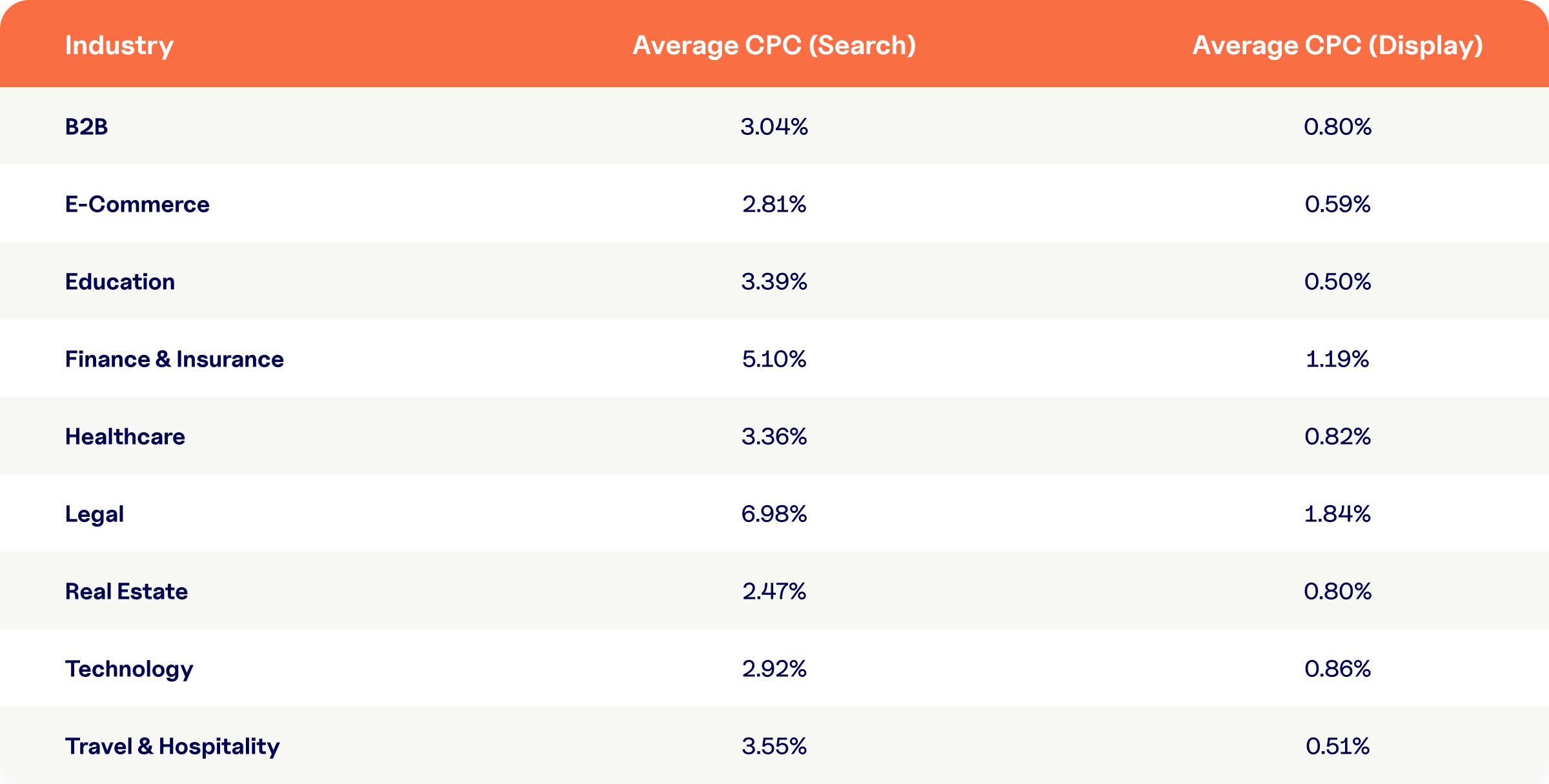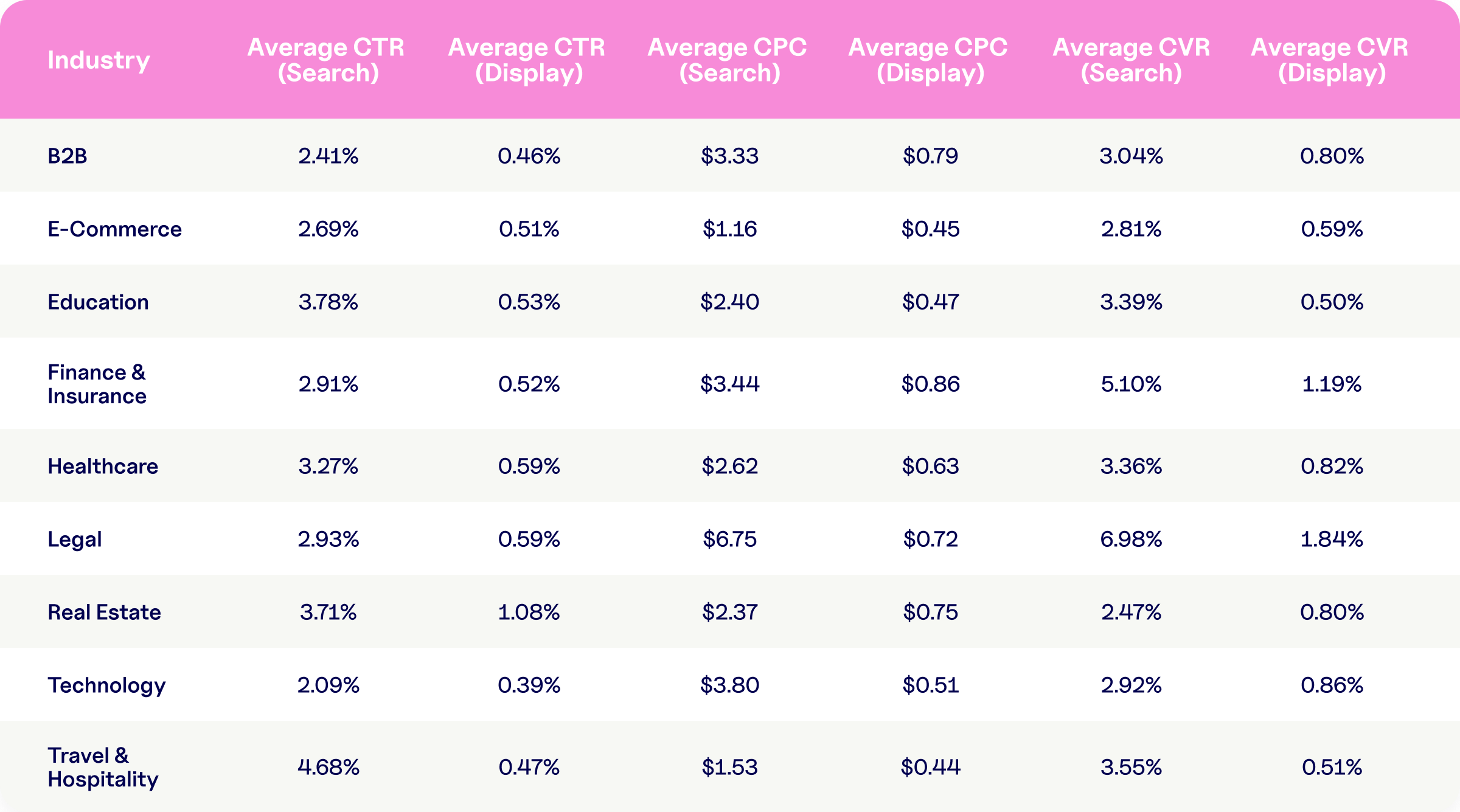Google Ads Benchmarks for 2025: What’s a Good CTR, CPC, and Conversion Rate?
When you’re spending real money on Google Ads, you don’t want “fun but useless.” You want results. But how do you know if your click-through rate (CTR), cost per click (CPC), or conversion rate is actually good?
Industry benchmarks turn guesswork into strategy. They let you see how your campaigns stack up against competitors, spot inefficiencies, and set realistic performance goals. In 2025, staying competitive in paid search means not only running creative, targeted ads but also knowing your numbers and constantly optimizing.
We’ll walk you through the latest 2025 Google Ads benchmarks so you know exactly what a good CPC or CTR looks like—and give you clear, actionable tips to analyze your paid ad performance and drive better results.
Why Benchmarks Matter (and When to Ignore Them)
Benchmarks are your context clues in the noisy world of Google Ads. Without them, you might feel like your campaigns are performing well, but you have no idea if you're really keeping up with competitors or leaving money on the table.
But here’s the thing: benchmarks aren’t one-size-fits-all. What’s “good” varies wildly by industry. A 2% CTR might be stellar for B2B SaaS but underwhelming for e-commerce. Legal service CPCs can be sky-high, while retail might pay a fraction. And conversion rates depend entirely on your offer, funnel, and audience.
That’s why context is everything. Benchmarks are guideposts, not gospel. The “right” numbers depend on your ad type (search vs. display), your goals (awareness vs. direct response), your budget, and your market. Use them to spot trends, set expectations, and identify gaps, but always tailor your strategy to what works for you.
Core Google Ads Metrics to Track
Before you can measure success against benchmarks, you need to know which metrics count. Let’s break down the core Google Ads performance metrics to track.
What is a Good CTR for Google Ads?
Click-through rate (CTR) measures how often people click your ad after seeing it. It’s a direct signal of how compelling your ad copy, headline, and offer are—and how well your targeting aligns with search intent.
Based on the latest data, a good Google Ads CTR in 2025 is typically 4–6% on search, but that average can swing much higher or lower depending on your niche. For display campaigns, expect lower CTRs (often below 1%), since those ads are more about awareness than direct response.
2025 Average CTR Benchmarks by Industry

Pro-Tip: Don’t obsess over absolute numbers. Instead, use benchmarks to spot trends. If you’re under industry averages, experiment with new headlines, better ad extensions, and more precise keyword targeting.
What is a Good CPC?
Cost-per-click (CPC) is how much you pay when someone clicks on your ad. It’s the price of attention, and the more competitive your industry or keyword, the higher it tends to be. Google Ads uses a real-time auction system, so your CPC depends on factors like keyword demand, competition, Quality Score, and even time of day or device targeting.
For 2025, average CPCs on search campaigns range from around $1 to over $10, depending on the industry. Highly competitive verticals like legal and finance can see CPCs in the $8–$12+ range, while travel and education may average closer to $1–$3.
2025 Average CPC Benchmarks by Industry

Pro-Tip: Lower CPC isn’t always better. A $10 click that converts at 10% beats a $2 click that converts at 1%. Always look at CPC alongside conversion rate and ROI.
What is a Good Conversion Rate?
Conversion rate (CVR) measures the percentage of clicks that lead to a desired action, like purchases, sign-ups, or leads. It’s arguably the ultimate metric, showing how well your ads and landing pages turn interest into results.
Conversion rates vary not just by industry, but by funnel stage, offer, ad type, and even seasonality. Great targeting and compelling creative mean nothing if your landing page is slow, confusing, or misaligned with the ad.
In 2025, average conversion rates for Google Ads search campaigns range from 2–5% overall, but can vary significantly by industry.
2025 Average CVR Benchmarks by Industry

Pro-Tip: To improve conversion rates, focus on aligning ad messaging with landing pages, simplifying forms, offering strong value propositions, and testing continuously.
Analyzing Paid Ad Performance Like a Pro
Benchmarks are a great starting point, but they’re not the finish line. The smartest advertisers use them as guideposts, not handcuffs. Don’t obsess over hitting an industry average to the decimal. Instead, think strategically about why your metrics look the way they do and where you can improve.
For example, early-funnel campaigns designed for awareness will almost always have lower conversion rates than bottom-funnel retargeting campaigns—and that’s fine! A search ad targeting high-intent keywords should outperform a broad display ad in CTR. If your goals, audience, or ad formats change, your “good” benchmarks should too.
Instead of chasing perfect numbers, ask the real questions:
- Does my CPC make sense given my conversion rate and customer value?
- Is my CTR healthy for my industry and targeting?
- Are my conversions profitable, not just plentiful?
And don’t let “vanity metrics” seduce you. A sky-high CTR is fun to brag about at the marketing happy hour, but it’s worthless if no one converts. Likewise, a dirt-cheap CPC doesn’t matter if those clicks bounce immediately.
How to Improve Your Google Ads Performance
So you’ve checked your benchmarks, analyzed your metrics like a pro, and maybe found a few opportunities. Don’t panic. The beauty of Google Ads is that everything is testable, tweakable, and improvable. Here’s how to level up your Google Ads performance:
Boosting Your CTR (without clickbait!)
A higher CTR means better relevance, a stronger Quality Score, and often lower costs. But let’s be clear: tricking people with clickbait headlines is a surefire way to waste budget and erode trust. Instead:
- Get laser-focused on intent. Align your keywords with your ad copy so it answers exactly what the user is searching for.
- Use clear, compelling value propositions. What sets you apart? Don’t be shy about spelling it out.
- Leverage ad extensions. Sitelinks, callouts, and structured snippets make your ad bigger, more useful, and more clickable.
- Test variations constantly. Even tiny copy tweaks can deliver surprising lifts.
Lowering CPC Without Lowering Quality
Who doesn’t want cheaper clicks? But cheap clicks that don’t convert are even worse than expensive ones that do. The trick is to lower your effective CPC by improving efficiency:
- Boost your Quality Score. Relevant keywords + compelling ad copy + good landing page = lower bids for the same placement.
- Refine your targeting. Negative keywords, geo filters, device bids—cut wasted impressions.
- Choose the right match types. Broad match can invite irrelevant clicks; consider phrase or exact, where precision matters.
- Optimize bidding strategies. Smart Bidding can help, but keep a close eye on performance.
Upping Your Conversion Game
Clicks are nice. Conversions pay the bills. If your conversion rate is lagging behind benchmarks, start here:
- Align ads with landing pages. Keep messaging consistent to avoid confusing visitors.
- Simplify your forms. Fewer fields = higher completion rates.
- Strengthen your offer. Discounts, bonuses, limited-time deals—give them a reason to act now.
- Build trust. Reviews, security badges, clear policies—small signals make a big difference.
- Test everything. Headlines, images, calls to action—continuous improvement wins over time.
Pro-Tip: If you're ready to move beyond averages and unlock real performance gains, explore Terra’s performance marketing and paid search services.
What 2025 Trends Mean for Your Ads
The world of Google Ads never sits still, and 2025 is no exception. Staying competitive means understanding not just your benchmarks, but the bigger shifts shaping the game. Here are our hot takes on the trends you can’t ignore this year:
- 🔥 Automation & Smart Bidding: Google’s machine learning isn’t going anywhere. Smart Bidding strategies are better than ever at optimizing for your goals, but don’t just set and forget. Keep feeding it high-quality conversion data and double-check that you’re not overpaying for vanity goals.
- 🔥 First-Party Data Is King: As privacy rules tighten and cookies crumble, relying on third-party audiences is riskier than ever. Build your own data. Email lists, CRM integrations, and consent-based remarketing will be essential for targeting that doesn’t vanish with the next policy change.
- 🔥 AI-Generated Creative (Friend or Foe?): Sure, AI can help you churn out headlines and variations at scale. But watch out—it can also produce generic, soulless ad copy that’s about as persuasive as elevator music. The best approach? Use AI to brainstorm, but keep a human in the loop to ensure your message actually sells.
TL;DR—Benchmarks at a Glance
Short on time? Check out your 2025 cheat sheet for Google Ads benchmarks, so you can see exactly where you stand.

Quick Tips to Help Beat the Benchmarks
- Get laser-focused on targeting. More relevance = better CTR and lower CPC.
- Write irresistible (but honest) ad copy. Avoid clickbait that doesn't convert.
- Refine your keyword strategy. Don’t waste budget on irrelevant searches.
- Align ads with landing pages. Messaging consistency boosts conversion rates.
- Speed up your landing pages. Slow pages kill conversions faster than anything else.
- Embrace smart bidding—but monitor it. Automation helps, but oversight wins.
- Test. Learn. Repeat. The best campaigns evolve with constant optimization.
Related Insights
We’re looking forward to working with you, too.
Start conquering the digital terrain today.





